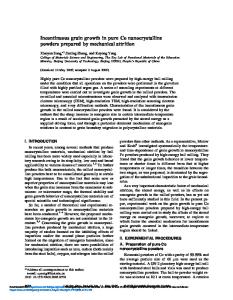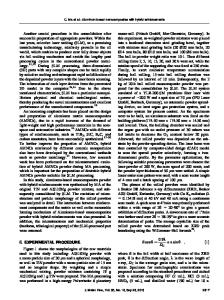Coercivity in nanostructured FeCo-based powders prepared by mechanical alloying
- PDF / 810,116 Bytes
- 6 Pages / 612 x 792 pts (letter) Page_size
- 15 Downloads / 379 Views
0980-II06-09
Coercivity in Nanostructured FeCo-Based Powders Prepared by Mechanical Alloying Qi Zeng1, Ian Baker1, Virginia McCreary2, and Zhicheng Yan3 1 Thayer School of Engineering, Dartmouth College, Hanover, NH, 03755 2 Department of Materials Science and Engineering, Columbia University, New York, NY, 10027 3 Department of Physics and Astronomy, University of Delaware, Newark, DE, 19716
ABSTRACT FeCo-based nanostructured powders were prepared by mechanical alloying and subsequently heat treated in an attempt to reduce their coercivity, HC. Although the powders had grain sizes smaller than the magnetic exchange length, a low HC, as expected from Herzer’s model, did not occur. The results of magnetic measurements on dilute and concentrated samples of the powder, as well as measurements of the temperature dependence of the magnetic properties from 10-300 K, indicate that the degree of magnetic interaction between the individual powder particles determines the relatively high HC of 10-20Oe at room temperature. INTRODUCTION FeCo-based soft magnetic materials have the highest saturation magnetization (MS) of any material, as well as high Curie temperatures, making these materials ideal for high temperature applications. Nanocrystalline HITPERM soft magnetic materials are usually manufactured in a thin ribbon form by rapid quenching from the melt. By annealing these amorphous precursors, a microstructure consisting of nanoscale B2-structured FeCo particles embedded in a residual amorphous phase is formed. The origin of magnetic softening by reducing the grain size into the nanoscale range has been explained based on Herzer’s so-called random anisotropy model [1]: Herzer’s model fits the data very well in many ribbon and thin film systems. Herzer’s relationship was also apparently observed in mechanical alloyed (MA) powders of Fe62Co38 [2], Fe75Si25 [3] and FeNi10-20 [4]. Our recent studies [5], however, did not show a grain size dependence of HC for MA Fe50Co50 powders over the grain size range 10100nm. In the present study, we annealed MA FeCo-based powders and investigated their soft magnetic properties, with a focus on the coercivity dependence of the grain size and the coercivity mechanisms, and tried to identify the reason why HC was high even at small grain sizes. In order to study the effects of both the magnetocrystalline, K1, and stress induced anisotropy on HC, Fe70Co30 and Fe50Co50 alloys were studied. Fe70Co30 has a higher K1, but only half the magnetostriction (λS) of Fe50Co50. (Fe0.5Co0.5)88Cu1Zr7B4 alloy was studied for comparison with HITPERM alloy film or ribbon. B and Zr were also added to Fe-Co binary alloys in order to study the effect of oxide particles which inhibit grain growth during annealing [6].
EXPERIMENT Nanocrystalline powders with nominal compositions of Fe70Co30, Fe50Co50, Fe69.97Co30B0.03, Fe49.2Co50Zr0.8, and (Fe0.5Co0.5)88Cu1Zr7B4 were prepared by mechanical alloying elemental powders for 10h under argon using a SPEX 8000 mixer/mill. A ball-topowder weight ratio of 10:1 was used
Data Loading...











